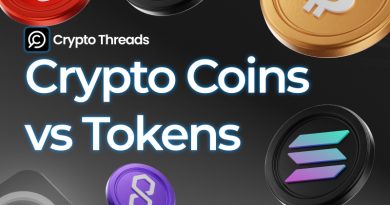How Do Popular Crypto Wallets Like MetaMask, Rainbow and Phantom Work?
What Is a Crypto Wallet?
Think of a crypto wallet as a special kind of digital wallet, similar to the physical wallet you use every day. However, instead of holding cash and credit cards, a crypto wallet stores special “keys” called cryptographic keys. These keys serve as proof that you own digital assets on the blockchain.
Here’s something that might surprise you: the actual coins or tokens aren’t stored in your wallet like you might imagine. Instead, the blockchain records all transactions, and your wallet simply stores your private key – the key that allows you to prove ownership and move those assets.
Understanding Public and Private Keys
To better understand how wallets work, imagine the wallet’s key system like an email system:
Public keys are like your email address – you can share them with anyone who wants to send you money. This information is safe to make public.
Private keys are like your email password – absolutely never share them with anyone. This key allows you to access your assets and make transactions. If you lose your private key, you’ll lose access to all assets in your wallet forever.
Types of Crypto Wallets
Hot Wallets vs Cold Wallets
Categorizing wallets based on internet connection is like distinguishing between a safe at home and a bank vault:
Hot wallets are always connected to the internet, including web wallets, mobile apps, and computer software. They’re convenient for daily transactions but carry higher security risks due to being constantly online.
Cold wallets operate offline like hardware wallets or paper wallets. They’re more secure but less convenient for frequent transactions, making them suitable for storing large amounts of assets for extended periods.
Custodial vs Non-Custodial Wallets
This difference is like comparing keeping money in a bank versus keeping cash at home:
Custodial wallets (commonly found on exchanges) are like depositing money in a bank – they manage the keys for you. This is simple but requires trusting a third party.
Non-custodial wallets allow you to manage your own private keys, like keeping cash at home. You have complete control but also bear full responsibility for security.
Understanding Popular Wallets
MetaMask: The Pioneer
MetaMask can be considered the “Internet Explorer of the crypto wallet world” – not because it’s outdated, but because it was one of the first and most widely adopted wallets.
MetaMask is designed primarily for the Ethereum ecosystem, operating as a browser extension. This means you can easily interact with decentralized applications directly from your web browser. The wallet securely stores your private keys on your computer, encrypted and protected by a password.
However, MetaMask’s interface hasn’t been updated extensively in recent years and is somewhat less user-friendly compared to newer wallets.
Rainbow: Focusing on User Experience
Rainbow emerged with the goal of addressing MetaMask’s limitations. If MetaMask is like an old but reliable car, then Rainbow is like a modern vehicle with beautiful design and user-friendly features.
Rainbow supports multiple blockchains, allowing you to manage diverse digital assets from various networks within the same application. Its interface is designed to make cryptocurrency usage more understandable, especially for beginners.
Phantom: The Solana Specialist
Phantom was originally developed specifically for the Solana blockchain, which makes it unique. If other wallets are like cars running on the Ethereum highway, then Phantom is like a vehicle specially designed for Solana’s separate road.
Solana is built using the Rust programming language and isn’t compatible with Ethereum, creating a distinct ecosystem. Phantom leverages Solana’s fast speed and low costs to deliver a smooth transaction experience.
Recently, Phantom has expanded to become a multi-chain wallet, supporting Ethereum and even Bitcoin through Ordinals and BRC-20 tokens.
Essential Security Measures
Protecting your crypto wallet is like protecting your home – it requires multiple layers of security:
Regular Wallet Backups
Think of your recovery phrase (seed phrase) as a master key. Store it in multiple secure locations such as encrypted USB drives or write it on paper and keep it in a safe. This is the most critical step because losing this phrase means permanently losing access to your assets.
Regular Software Updates
Like locking your house doors, updating wallet software helps patch newly discovered security vulnerabilities. Developers regularly release updates to enhance security.
Stay Alert for Scams
Crypto phishing attacks are like someone impersonating a bank employee calling to ask for your ATM card information. Always carefully verify the authenticity of websites and emails before entering sensitive information.
Use Cold Storage for Large Amounts
For long-term storage, cold wallets are like depositing money in a bank vault – secure but less convenient for daily use.
Monitor Account Activity
Regularly checking your wallet’s transaction history is like reviewing bank statements. If you notice unusual activity, immediately change passwords and move assets to a new wallet.
Building Your Understanding Step by Step
Let me walk you through how these concepts work together in practice. When you first set up any of these wallets, you’re essentially creating a mathematical relationship between your public and private keys. The public key becomes your address that others can see on the blockchain, while your private key remains hidden on your device.
Every time you make a transaction, you’re using your private key to create a digital signature that proves you own the assets you’re trying to move. The blockchain network verifies this signature against your public key, and if everything matches, the transaction is approved and recorded permanently.
This system is what makes cryptocurrency “trustless” – you don’t need to trust a bank or government because the mathematics and cryptography handle the verification automatically.
Choosing the Right Wallet for Your Needs
Consider your crypto journey like choosing transportation. If you’re just starting and mainly interested in Ethereum-based projects, MetaMask provides a solid foundation with extensive compatibility. It’s like choosing a reliable sedan that gets you where you need to go.
If you value a beautiful, intuitive interface and plan to explore multiple blockchains, Rainbow offers an excellent user experience. Think of it as choosing a modern car with all the latest comfort features.
If you’re drawn to the Solana ecosystem or want to experience lightning-fast, low-cost transactions, Phantom provides specialized tools for that environment while now supporting other chains as well. It’s like having a sports car that excels on certain roads but can also handle everyday driving.
Conclusion
MetaMask, Rainbow, and Phantom are all excellent non-custodial hot wallets, each with distinct advantages. MetaMask suits those familiar with Ethereum, Rainbow works well for beginners wanting a beautiful interface, and Phantom is an excellent choice for those interested in the Solana ecosystem.
Regardless of which wallet you choose, remember that securing your digital assets is your responsibility. Understanding how they work and implementing appropriate security measures will help you confidently manage your cryptocurrency assets. Take time to practice with small amounts first, and gradually build your comfort level as you become more familiar with the technology.
The world of cryptocurrency wallets might seem complex at first, but like learning to drive a car, once you understand the basic principles and practice the safety measures, it becomes second nature.



